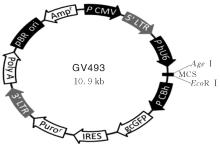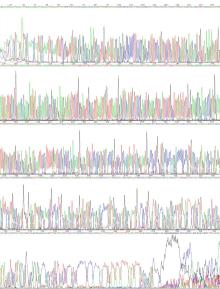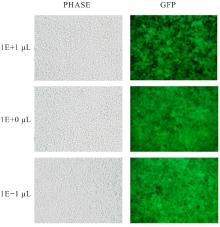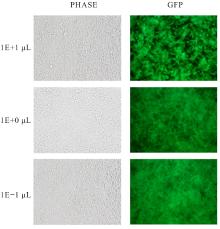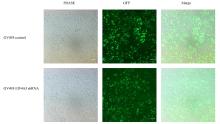| [1] |
Yeteng MU,Chong GUO,Nannan HU,Fuxu YANG,Han XUE,Yuxin FAN,Fenglin GUO,Xingang GUAN.
Construction of immune checkpoint TIGIT lentivirus expression vector and establishment of cell line stably expressing TIGIT
[J]. Journal of Jilin University(Medicine Edition), 2022, 48(5): 1341-1347.
|
| [2] |
Pei GONG, Jingran LIU, Shimin ZHAO, Yuzhen WANG, Jiming XIE.
Inhibitory effect of MCM10 silencing on proliferation of breast cancer MDA-MB-231 cells and its mechanism
[J]. Journal of Jilin University(Medicine Edition), 2021, 47(3): 652-659.
|
| [3] |
Chongjun XU,Hefan HE,Qun LIN,Tao ZHANG.
Construction of human hepatocyte growth factor gene lentivirus vector and its expression in bone marrow mesenchymal stem cells
[J]. Journal of Jilin University(Medicine Edition), 2021, 47(1): 16-24.
|
| [4] |
CHEN Shaofeng, LI Shengnan, DENG Fu, ZHU Peiyi, LI You.
Construction of RHBDF2 gene over-expression lentivirus vector and establishment of RHBDF2 cell line stably expressing RHBDF2
[J]. Journal of Jilin University(Medicine Edition), 2020, 46(03): 444-450.
|
| [5] |
LI Shengnan, CHEN Wuhai, CHEN Shaofeng, DENG Fu, ZHU Peiyi, LI You.
Construction of RHBDF2-shRNA lentiviral vector and establishment of stably transfected Neuro-2a-RHBDF2-shRNAcell line
[J]. Journal of Jilin University(Medicine Edition), 2019, 45(06): 1224-1230.
|
| [6] |
LI Shengnan, WANG Mengxu, HU Weidong, CHEN Shaofeng, CHEN Xinglan, LI You.
Construction and identification of miR-186 overexpression lentiviral vector
[J]. Journal of Jilin University(Medicine Edition), 2019, 45(05): 997-1002.
|
| [7] |
LIANG Chunmei, XU Xusan, YU Huajun, ZHOU Xia, WEN Xia, LI You, KOJIC Snezana, WANG Yajun, MA Guoda.
Construction and identification of recombinant lentivirus overexpression and RNA interference vector containing cardiac adriamycin reactive protein gene
[J]. Journal of Jilin University(Medicine Edition), 2019, 45(04): 766-771.
|
| [8] |
WANG Mengxu, LI Shengnan, HU Weidong, CHEN Shaofeng, CHEN Xinglan, LI You.
Construction of miR-186 sponge vectorand its expression in EA.hy926 cells
[J]. Journal of Jilin University(Medicine Edition), 2019, 45(03): 498-503.
|
| [9] |
LYU Dong, LIANG Chunmei, LI Mingying, YIN Jingwen, LUO Xudong, LIN Juda, MA Guoda.
Packaging and identification of miR-137 overexpression lentivirus
[J]. Journal of Jilin University Medicine Edition, 2017, 43(04): 694-697.
|
| [10] |
YANG Yaoqun, XIE Shuli, LYU Guoyue, MA Qiang, LI Kailiang, WANG Guangyi.
Influence of P27RF-RhO mRNA gene silencing in drug sensitivity of 5-fluorouracil in liver cancer SMMC7721 cell line
[J]. Journal of Jilin University Medicine Edition, 2017, 43(02): 271-275.
|
| [11] |
MA Qiang, XIE Shuli, WANG Guangyi, XING Guangyuan, YANG Yaoqun, LYU Guoyue.
Influence of lentiviral-mediated P27RF-Rho gene silence in invasion of liver cancer cells
[J]. Journal of Jilin University Medicine Edition, 2016, 42(02): 260-265.
|
| [12] |
GAO Xingchun, GUO Na, YAN Aili, FENG Hao, SHI Hongen, GOU Xingchun.
Inhibitory effect of RNA silencing FZD4 expression on self-renewal ability of glioma stem cells
[J]. Journal of Jilin University Medicine Edition, 2015, 41(04): 701-705.
|
| [13] |
WANG Ke, ZOU Jiyan, WANG Li, DU Zhenwu, WANG Junrong, YE Cong, PAN Ying.
Construction of RhoC lentivirus interference vector and its effect on expression of RhoC mRNA in ovarian cancer SKOV3 cells
[J]. Journal of Jilin University Medicine Edition, 2015, 41(02): 304-306.
|
| [14] |
WANG Zihang, ZHANG Yuhong, XIA Daozi, LI Guangsen, WU Jun, YOU Yue, HUANG Dongmei, BO Huaying, HU Bin, MAO Xin.
Inhibition of expression of JNK1 in mouse hepatocellular carcinoma cell lines and cell migration and invasion mediated by ultrasound-targeted microbubble destruction
[J]. Journal of Jilin University Medicine Edition, 2015, 41(01): 21-26.
|
| [15] |
CAO He,LI Wei,QIAN Lei,WANG Xue-mei,CUI Jiu-wei.
Inhibitory effect of COPS3 gene interferred by RNA on proliferation of lung cancer A549 cells and its mechanism
[J]. Journal of Jilin University Medicine Edition, 2014, 40(02): 238-242.
|
 ),Keqi LIAO2,Shengnan LI1,2(
),Keqi LIAO2,Shengnan LI1,2( )
)
